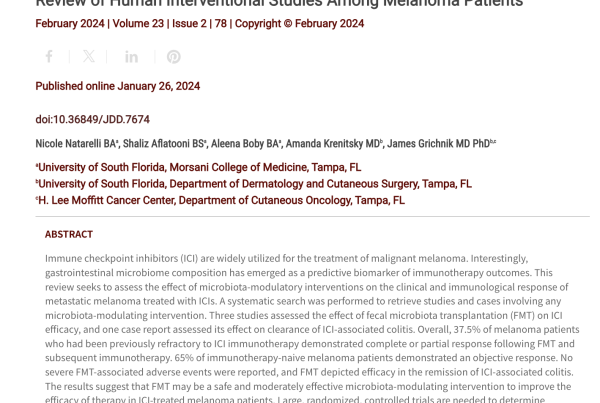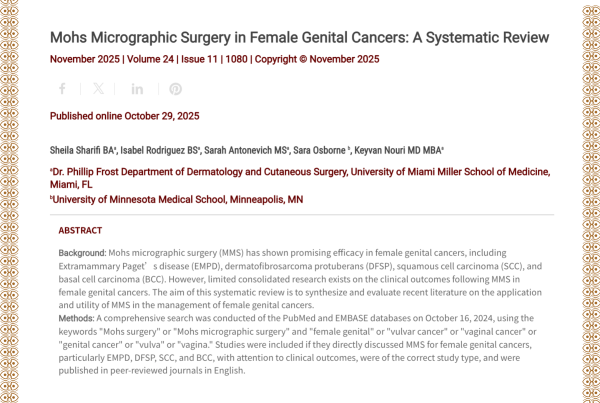Skin Cancer Podcast
Support the (On)cause: A Practical Review of Supportive Oncodermatology
Cancer sucks, plain and simple. What is often overlooked is that the life saving/altering therapies often come with substantial baggage adding to this proclamation with skin, hair, and nail adverse events significantly impacting quality of life and even treatment course.
Enter supportive oncodermatology, and along with it the mastermind behind this rapidly emerging field, Dr. Mario Lacouture, Professor and Director of the Oncodermatology Program in the Dermatology Service, Department of Medicine, at Memorial Sloan Kettering Cancer Center in New York City.
Dr. Lacatoure joins podcast host Dr. Adam Friedman to discuss the array of cutaneous clusters that not only can, but are almost expected to occur during cancer therapy. Learn how even simple OTC products can contribute to both ameliorating and even preventing some of these sequelae. Understand how you (yeah, I’m talkin’ to you) can make an extraordinary impact in these patients’ lives. Tune in to this podcast to support your supportive oncoderm fund of knowledge.
How Do You Celebrate the Birthday Suit: Variations in Skin Cancer Screening Practices Among Dermatologist
In this edition of the JDD podcast “Ask the Investigator,” host Dr. Adam Friedman from the GW School of Medicine and Health Sciences is joined by Dr. Evan Rieder, Assistant Professor of Dermatology at NYU Langone Medical Center and one of the few dermatologists double board certified in dermatology and psychiatry in the U.S., to discuss his recent study entitled “Dermatologist Practices During Total Body Skin Examinations: A Survey Study.” Do we all do it the same? Are we all checking every nook and cranny? Do we need better standardization for our greatest weapon to enable early and life saving skin cancer detection? Call me crazy, but this is pretty…..preeeetty… pretty important (as Larry David would say).
Sponsored
Case Reports
Basal Cell Carcinoma in the Nasal Vestibule
Basal cell carcinomas (BCC) arise from DNA damage to cells of the basal layer of the epidermis and most commonly in areas of the skin exposed to sunlight or ultraviolet radiation. BCC is the most common skin cancer seen in humans with over 4.3 million cases reported in the United States and is responsible for 3-10% of all cancers annually. We report what we believe to be the first case of this very prevalent skin cancer arising in the nasal vestibule. The lesion was treated with Mohs micrographic surgery and required three stages to obtain histological clearance. Given the location of the tumor, Mohs surgery was chosen due to the procedure’s effectiveness for achieving the highest cure rate with the lowest incidence of tumor recurrence and for preserving as much adjacent healthy tissue as possible
Combination Topical Chemotherapy for the Treatment of an Invasive Cutaneous Squamous Cell Carcinoma
Standard of care for squamous cell carcinoma (SCC) is usually surgical, with either excision or Mohs micrographic surgery. However, surgery may not be ideal for elderly patients with numerous lesions, who are poor surgical candidates or who refuse surgery. Topical 5-fluorouracil (5-FU) and imiquimod have been studied off-label as monotherapies in the treatment of SCC in situ with promising results. However, long-term tumor-free survival rates are still less than with surgical management.
.
Recurrent Squamous Cell Carcinoma Arising Within a Linear Porokeratosis
Here we report a case of linear porokeratosis with recurrent malignant degeneration to squamous cell carcinoma (SCC) recurring six years after excision of initial SCC. A 79-year-old woman presented with a friable tumor located within a longstanding lesion on her posterior thigh. Six years prior, she was diagnosed with SCC arising within the same lesion, which had been surgically excised with negative margins. Physical examination revealed a 3.5 x 2.7 cm friable tumor on the left proximal posterior thigh.
Supplements
Skin Cancer in Hispanics in the United States
The Hispanic population in the United States has reached nearly 58 million in 2016 and has been the principal driver of U.S. demographic growth, accounting for half of national population growth since 2000. In 2016, Hispanics accounted for 18% of the nation’s population and were the second-largest racial or ethnic group behind whites making the people of Hispanic origin the nation’s largest ethnic or racial minority.1The projected Hispanic population of the United States is 119 million by 2060. According to this projection, the Hispanic population will constitute 28.6 percent of the nation’s population by that date.2 Hispanics are the youngest major racial or ethnic group in the United States. About one-third, or 17.9 million, of the nation’s Hispanic population is younger than 18, and about a quarter, or 14.6 million, of all Hispanics are Millennials (ages 18 to 33 in 2014), according to a Pew Research Center analysis of U.S. Census Bureau data. The Hispanic population within the United States is younger than the Caucasian population. Fifty-seven percent of Hispanic married-couple households had children younger than 18 present in 2014, whereas for the nation it was 40.1 percent.3 This population is made of 64% born within the U.S. and 36% immigrants.1 Hispanics of Mexican origin account for 63.3% (36 million) of the nation’s Hispanic population in 2015, by far the largest share of any origin group, but down from a recent peak of 65.7% in 2008. Another 9.5% were of Puerto Rican background, 3.7% Cuban, 3.7% Salvadoran, 3.3% Dominican, and 2.4% Guatemalan.4 The five states that have the largest concentration of Hispanics are California, Texas, Florida, New York, and Illinois. Nearly half of all Hispanics live in California and Texas. Fifteen million live in California, 10.4 million in Texas, 4.2 million in Florida, 3.4 million in NY, and 2 million in Illinois.5
Sponsored
JDD Blog










